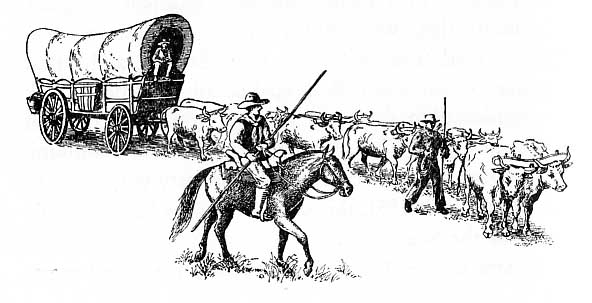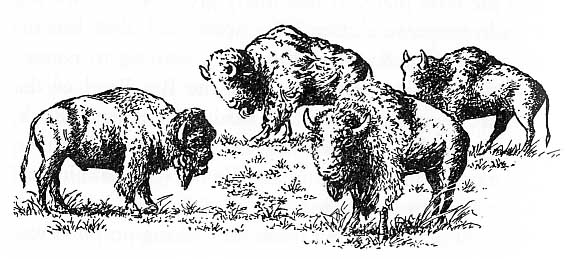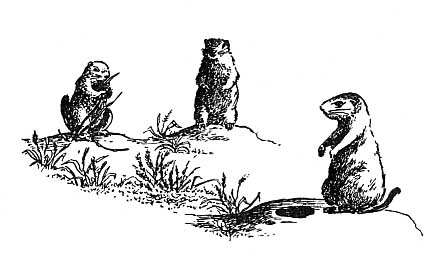
63
Although I was not yet twenty-one, I felt like Rip Van Winkle after this absence of almost a year and a half. Events of great national importance had occurred during that interval. In November, 1860, Lincoln was elected president on the Republican ticket. His platform called for the immediate admission of Kansas into the Union. When this took place, January 29, 1861, the news was greeted by bonfires and the ringing of bells. In February, the free-state leader of Lawrence, Charles Robinson, took the oath as first governor.
Ever since 1854, free-state settlers in Kansas had been forced to shoulder arms to protect their towns from pro-slavery agitators. When, in April 1861, Fort Sumter was fired upon, the outright struggle became nation-wide. Eleven states seceded, splitting the country North and South.
In spite of the fact that Kansas still suffered from drought and internal warfare, she responded to Lincoln's first call for volunteers with a regiment of 650 men. These troops proved their mettle and went into battle singing.
By autumn there was a lull in the fighting. Lincoln was trying to arbitrate with the Confederates, and many thought the war was over. Instead of enlisting then, I took a commission to drive six yoke of oxen in a train of wagons, carrying 6,500 pounds of revolvers and ammunition to Fort Union, New Mexico. For forty years after its establishment in 1851, this outpost was the largest supply depot in the Southwest.
I went to Fort Leavenworth to help load the64
twenty-six wagons at the government headquarters. We checked each wagon to make sure that bows, axles, tires, and yokes were in good condition and with enough spare bolts to last throughout the 873-mile journey. This was in the spring of '62. As soon as grass on the prairies would be green enough to pasture the animals, we made ready to start.
Six yoke of oxen were hitched to each wagon. They were steadier than mules or horses and could pull heavier loads through mud and sand. A captain, a lieutenant, and extra man were mounted on mules. Our crew of twenty-six "bull whackers" was a motley array of farmers, back-woodsmen, and city-bred merchants, glad of the chance to earn forty dollars a month during the three months' trip, when other work was scarce.
On the day set for our departure we were up before the crack of dawn. The command, "Catch up, catch up!" spread over the camp.
When each teamster was ready, he replied, "All's set!"
"Fall in!" shouted the captain.
The creaking wagons of our bulky freight caravan began to move. We drove three or four miles before

65
stopping for breakfast. The oxen were unyoked and turned out to graze until afternoon, when we drove four or five miles farther. Then came another period for grazing. We had supper about four o'clock—just two meals a day, followed by a drive of four or five miles before stopping for the night. The average daily distance covered was from twelve to fifteen miles, although sometimes an entire day was consumed in crossing a stream. There was not a single bridge along the Santa Fe Trail.
At night the wagons were corralled in the form of an ellipse, leaving a gap at one end about thirty feet wide, where cattle could be driven in for yoking up. This formation served as protection in case of Indian alarms. Two men were detailed as night herders, and usually eight night watchers stood guard on alternate nights during certain hours. Occasionally wagon trains were escorted by outriders for added daytime protection, but supply trains seldom had military guard. We did, however, have guns and ammunition. Out on the plains, traders invariably banded together for mutual safety, as we did on the Colorado trip.
From Leavenworth the trains for New Mexico had a choice of two different routes. One led through the Delaware reservation past Tonganoxie, crossing the Kaw at Lawrence. The other crossed the river at Topeka, either at Papan's ferryboat or by fording, and went southwest near Auburn. Both of the Leavenworth trails joined a trail from Independence, Missouri, at Wilmington, west of Burlingame.
This long winding pathway, from sixty to a hundred feet wide, tying the United States to Mexico and crossing the length of Kansas, followed the original buffalo trails66
from one river to another. Travel by pack mules began with Captain William Becknell of Missouri in 1822. Four years later wagons supplanted pack animals, and the Santa Fe Trail became a great inland wagon road across the unbroken prairies. By 1862, when I played my small part in the vast commerce of the plains, this was one of the most traveled routes in the world. For ten more years it contributed materially to the development of the great West. In 1872 the railroad put the overland freighter out of business.
Council Grove, 150 miles from Independence, was the most important stopping place on the trail, and the last outfitting station. At a small stone building called the "Last Chance Store" overland trains could stock up on flour, bacon, and other provender. In fact, everything from needles to harness repairs was available. Indians traded buffalo robes and deer and wolf skins for coveted trinkets.
A strip of oak, walnut, elm, and hickory trees along the valley of the Neosho River was like an oasis on the barren plains. Here we cut logs to be used for repairs on axles, tongues, and coupling poles, and lashed them under the wagons. While the animals grazed and rested in the cool shelter of the timber, I wandered about the busy outpost.
Seth M. Hays, a cousin of Kit Carson, kept a rambling two-story hotel and eating house where travelers met for refreshment and an exchange of news. A sturdy stone building once used as an Indian mission now served as a place for public gatherings. One mile east of town was Fremont Spring, named for my boyhood hero, "The Great Pathfinder." In 1845 General Fremont had used this site for an encampment. Big John Creek, near at hand, was67
named for one of his guides. When offered a pension for his services, Big John requested that instead of money he be given a new scout uniform each year.
Along Big John Creek the government in 1859 started a housing project for the Indians, erecting 150 stone cabins. The red men, however, preferred to live in their old wigwams and merely stabled their ponies in the cabins.
The Neosho River at Council Grove is comparatively shallow, with a hard rock bottom. Nevertheless, it took an entire day for our twenty-six wagons to ford the stream. Eighteen miles west was a good camping ground near Diamond Springs, where an inexhaustible fountain discharged its clear waters into a gurgling brook. There were ranches, so called, at Big Turkey Creek, the Little Arkansas (now Little River), Cow Creek, and Walnut Creek. These were really trading stations. After passing Peacock's station on the Walnut, the traveler found no habitation of any kind along the Cimarron and Aubrey routes until he reached Fort Union. On the Raton route he passed Bent's Fort and Trinidad, a Mexican hamlet at the foot of the Spanish Peaks.
Our trail followed the north bank of the Arkansas River—a beautiful and majestic stream, winding for miles across the level plain. It had many green islands, thickly set with cottonwood trees. We were told that Indians lurked in the bluffs along the valley, waiting to pounce upon unsuspecting travelers. Near the Big Bend of the Arkansas, we passed under the shadow of Pawnee Rock, a treacherous hiding place and lookout for hostile tribes, and the site of many skirmishes. We felt fortunate indeed to escape any encounter with the savages here.
The last place to gather wood for cooking purposes was68
at Ash Creek. After that, fuel was husbanded very carefully. Nailed to the side of each wagon was a large gunny sack into which drivers tossed any stray sticks or dry buffalo chips. The tall bluestem grass of the prairies now gave way to short buffalo grass. We had reached the heart of the buffalo country.
By crossing the Arkansas River at a point known as "the Cimarron," one could take a cutoff across Horn Alley, thus saving about seventy miles. Although this meant traveling from thirty-six to forty hours without water for man or beast, our captain decided to risk it. The river at the Cimarron Crossing was then nearly a mile wide and about three and a half feet deep.
Even though we hitched thirty-two cattle to each wagon, it was a hard steady pull. One man waded through the water to steer the lead oxen. Before we reached solid ground there were four miles of heavy sand. After all the wagons were safely across, we drove the cattle back the four miles to the river and watered them. We also filled five-gallon casks and other containers, hoping the water would last until we came to the Cimarron River.
The long dry march was begun in the evening, and we traveled all night. For the most part the road was hard

69
and level, with only a few sandy depressions. One morning a white mound appeared in the distance. I asked an old-timer what it was.
"The bone-yard," he replied. "It's a law of the plains for every driver to add at least one to the pile. They've been doing it for years."
Miles before the monument was reached, drivers were on the lookout for bones. The pile was shaped like a haystack, about forty feet in diameter and thirty feet high. Whoever got this collection a few years later, when bone-gathering became a profitable business, had a bonanza.
Between 1868 and 1881 many western communities subsisted largely on the income of eight dollars a ton, derived from buffalo bones. They were shipped east to make buttons and fertilizer, and to be used by carbon works in St. Louis and elsewhere. It was estimated that thirty-one million buffalo were slaughtered by white men for their hides and tongue alone, while the meat was left to rot on the plains. No wonder the Indians, who found a use for every last morsel, cried out against such wastefulness.
Our drive across the barren "water scrape," as this desert was called, continued with little rest all day and most of the second night. We were a weary crew. Men almost slept as they walked. I well remember staggering against a wheel and waking up just in time to avoid being crushed beneath it. For this very reason there were strict orders against riding on the tongue of the wagon.
When we were yet several miles from the Cimarron River, the thirsty cattle, their tongues dry and lolling, smelled the water. They became almost uncontrollable and nearly upset the wagons in trying to make a break for the70
stream. A three-day rest here where grass was plentiful gave animals and men a chance to recuperate.
On the Cimarron the water appeared in holes, often ten miles apart. It was impregnated with alkali, though not strong enough to hurt the cattle unless they drank too much, and looked perfectly clear until stirred up by the animals. Catfish that were forced to the surface for air could easily be caught with bare hands.
Indian tribes in this region were friendly and eager to trade almost anything for bacon or sugar. Sugar was, in fact, the currency of the plains. A cup of it would buy a finely beaded and balled pair of moccasins. Five cups paid for a rich black buffalo robe, smoke-tanned, and painted, and actually worth several hundred dollars. Sugar was rationed among the boys of our outfit. We could do without it in our coffee and trade it instead, if we chose.
One wagon boss, not in our train, who had been in the battle of Wilson Creek on the Confederate side, showed no scruples about appropriating anything from Uncle Sam. When his government wagon, loaded with sugar, stopped for a day at Wind Valley, he and his men opened hundreds of sacks, took several pounds of sugar from each, and carefully sewed them up again.
After leaving the Cimarron valley, we found that travel was routine, one day being like the preceding. There were Rabbit Ear and Red River to cross; and few teams could take their load over the Apache Hills without doubling. Wagon Mound was the last important landmark before we rolled into Fort Union, fifty days after leaving Leavenworth.
We unloaded, and the very next day started back to the States. As a rule, empty incoming trains took the71
Raton Pass. The trail came out of the mountains at Trinidad, following the Purgatory (or Purgatoire) River and striking the Arkansas near Bent's Fort. On one occasion, when the Arkansas was running strong, two wagons turned over while attempting to cross and were washed down the river a good half mile. One carried a man and his wife, passengers coming into the States, but both got out safely. After leaving Bent's Fort, we retraced the route to Leavenworth, where we were paid and discharged.
